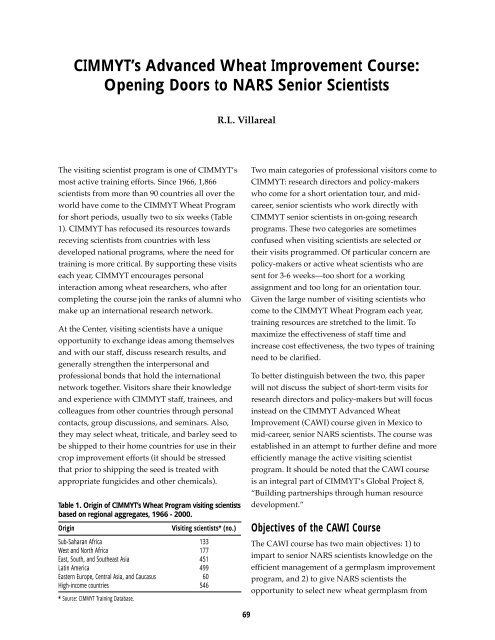Research Highlights of the CIMMYT Wheat Program 1999-2000
Research Highlights of the CIMMYT Wheat Program 1999-2000
Research Highlights of the CIMMYT Wheat Program 1999-2000
You also want an ePaper? Increase the reach of your titles
YUMPU automatically turns print PDFs into web optimized ePapers that Google loves.
<strong>CIMMYT</strong>’s Advanced <strong>Wheat</strong> Improvement Course:<br />
Opening Doors to NARS Senior Scientists<br />
R.L. Villareal<br />
The visiting scientist program is one <strong>of</strong> <strong>CIMMYT</strong>’s<br />
most active training efforts. Since 1966, 1,866<br />
scientists from more than 90 countries all over <strong>the</strong><br />
world have come to <strong>the</strong> <strong>CIMMYT</strong> <strong>Wheat</strong> <strong>Program</strong><br />
for short periods, usually two to six weeks (Table<br />
1). <strong>CIMMYT</strong> has refocused its resources towards<br />
receving scientists from countries with less<br />
developed national programs, where <strong>the</strong> need for<br />
training is more critical. By supporting <strong>the</strong>se visits<br />
each year, <strong>CIMMYT</strong> encourages personal<br />
interaction among wheat researchers, who after<br />
completing <strong>the</strong> course join <strong>the</strong> ranks <strong>of</strong> alumni who<br />
make up an international research network.<br />
At <strong>the</strong> Center, visiting scientists have a unique<br />
opportunity to exchange ideas among <strong>the</strong>mselves<br />
and with our staff, discuss research results, and<br />
generally streng<strong>the</strong>n <strong>the</strong> interpersonal and<br />
pr<strong>of</strong>essional bonds that hold <strong>the</strong> international<br />
network toge<strong>the</strong>r. Visitors share <strong>the</strong>ir knowledge<br />
and experience with <strong>CIMMYT</strong> staff, trainees, and<br />
colleagues from o<strong>the</strong>r countries through personal<br />
contacts, group discussions, and seminars. Also,<br />
<strong>the</strong>y may select wheat, triticale, and barley seed to<br />
be shipped to <strong>the</strong>ir home countries for use in <strong>the</strong>ir<br />
crop improvement efforts (it should be stressed<br />
that prior to shipping <strong>the</strong> seed is treated with<br />
appropriate fungicides and o<strong>the</strong>r chemicals).<br />
Table 1. Origin <strong>of</strong> <strong>CIMMYT</strong>’s <strong>Wheat</strong> <strong>Program</strong> visiting scientists<br />
based on regional aggregates, 1966 - <strong>2000</strong>.<br />
Origin<br />
Visiting scientists* (no.)<br />
Sub-Saharan Africa 133<br />
West and North Africa 177<br />
East, South, and Sou<strong>the</strong>ast Asia 451<br />
Latin America 499<br />
Eastern Europe, Central Asia, and Caucasus 60<br />
High-income countries 546<br />
* Source: <strong>CIMMYT</strong> Training Database.<br />
Two main categories <strong>of</strong> pr<strong>of</strong>essional visitors come to<br />
<strong>CIMMYT</strong>: research directors and policy-makers<br />
who come for a short orientation tour, and midcareer,<br />
senior scientists who work directly with<br />
<strong>CIMMYT</strong> senior scientists in on-going research<br />
programs. These two categories are sometimes<br />
confused when visiting scientists are selected or<br />
<strong>the</strong>ir visits programmed. Of particular concern are<br />
policy-makers or active wheat scientists who are<br />
sent for 3-6 weeks—too short for a working<br />
assignment and too long for an orientation tour.<br />
Given <strong>the</strong> large number <strong>of</strong> visiting scientists who<br />
come to <strong>the</strong> <strong>CIMMYT</strong> <strong>Wheat</strong> <strong>Program</strong> each year,<br />
training resources are stretched to <strong>the</strong> limit. To<br />
maximize <strong>the</strong> effectiveness <strong>of</strong> staff time and<br />
increase cost effectiveness, <strong>the</strong> two types <strong>of</strong> training<br />
need to be clarified.<br />
To better distinguish between <strong>the</strong> two, this paper<br />
will not discuss <strong>the</strong> subject <strong>of</strong> short-term visits for<br />
research directors and policy-makers but will focus<br />
instead on <strong>the</strong> <strong>CIMMYT</strong> Advanced <strong>Wheat</strong><br />
Improvement (CAWI) course given in Mexico to<br />
mid-career, senior NARS scientists. The course was<br />
established in an attempt to fur<strong>the</strong>r define and more<br />
efficiently manage <strong>the</strong> active visiting scientist<br />
program. It should be noted that <strong>the</strong> CAWI course<br />
is an integral part <strong>of</strong> <strong>CIMMYT</strong>’s Global Project 8,<br />
“Building partnerships through human resource<br />
development.”<br />
Objectives <strong>of</strong> <strong>the</strong> CAWI Course<br />
The CAWI course has two main objectives: 1) to<br />
impart to senior NARS scientists knowledge on <strong>the</strong><br />
efficient management <strong>of</strong> a germplasm improvement<br />
program, and 2) to give NARS scientists <strong>the</strong><br />
opportunity to select new wheat germplasm from<br />
69

















